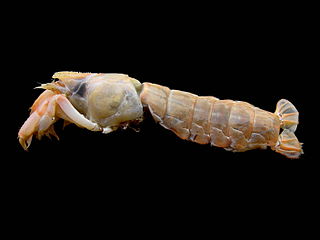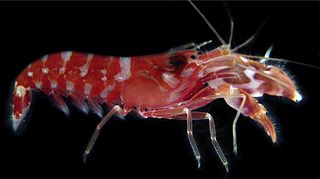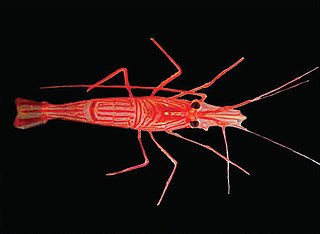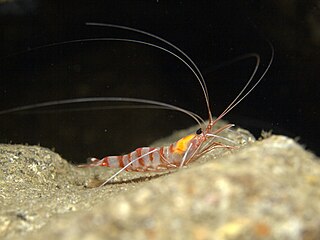
The Caridea, commonly known as caridean shrimp or true shrimp, from the Greek word καρίς, καρίδος, are an infraorder of shrimp within the order Decapoda. This infraorder contains all species of true shrimp. They are found widely around the world in both fresh and salt water. Many other animals with similar names – such as the mud shrimp of Axiidea and the boxer shrimp of Stenopodidea – are not true shrimp, but many have evolved features similar to true shrimp.

Anostraca is one of the four orders of crustaceans in the class Branchiopoda; its members are referred to as fairy shrimp. They live in vernal pools and hypersaline lakes across the world, and they have even been found in deserts, ice-covered mountain lakes, and Antarctic ice. They are usually 6–25 mm (0.24–0.98 in) long. Most species have 20 body segments, bearing 11 pairs of leaf-like phyllopodia, and the body lacks a carapace. They swim "upside-down" and feed by filtering organic particles from the water or by scraping algae from surfaces, with the exception of Branchinecta gigas, or "giant fairy shrimp", which is itself a predator of other species of anostracans. They are an important food for many birds and fish, and some are cultured and harvested for use as fish food. There are 300 species spread across 8 families.

Amphionides reynaudii is a species of caridean shrimp, whose identity and position in the crustacean system remained enigmatic for a long time. It is a small planktonic crustacean found throughout the world's tropical oceans, which until 2015 was considered the sole representative of the order Amphionidacea, due to unusual morphological features. Molecular data however confirm it as a member of the caridean family Pandalidae, and the confusion of morphology is because only larval phases have so far been studied.

Hippolytidae is a family of cleaner shrimp, also known as broken-back shrimp or anemone shrimp. The term "broken-back shrimp" also applies to the genus Hippolyte in particular and "cleaner shrimp" is sometimes applied exclusively to Lysmata amboinensis.

Lysmata debelius is a species of cleaner shrimp indigenous to the Indo-Pacific. It is popular in the aquarium trade, where it is known as the fire shrimp, blood shrimp or scarlet cleaner shrimp.

Cleaner shrimp is a common name for a number of swimming decapod crustaceans that clean other organisms of parasites. Most are found in the families Hippolytidae and Palaemonidae, though the families Alpheidae, Pandalidae, and Stenopodidae each contain at least one species of cleaner shrimp. The term "cleaner shrimp" is sometimes used more specifically for the family Hippolytidae and the genus Lysmata.

Upogebiidae is a family of mud shrimp crustaceans belonging to the infraorder Gebiidea, within the order Decapoda. They are infauna, living their entire adult lives in seafloor burrows. Over 100 species have been identified, with different species often highly specialized for different types of substrate, even including sea sponges or coral. They are filter feeders, although some species also deposit feed.

Palaemonidae is a family of shrimp in the order Decapoda. Many species are carnivores that eat small invertebrates, and can be found in any aquatic habitat except the deep sea. One significant genus is Macrobrachium, which contains commercially fished species. Others inhabit coral reefs, where they associate with certain invertebrates, such as sponges, cnidarians, mollusks, and echinoderms, as cleaner shrimps, parasites, or commensals. They generally feed on detritus, though some are carnivores and hunt tiny animals.

Typhlatya is a genus of shrimp in the family Atyidae. These are small, stygobitic shrimp found in the West Mediterranean region, Caribbean region, Ascension Island and the Galápagos, although the individual species often have very small ranges. Species in this genus are found in salt, brackish and fresh waters, mostly in anchialine habitats and none in the open sea.

Lysmata is a genus of shrimp in the infraorder Caridea, the caridean shrimp. The genus belongs to the family Lysmatidae. Lysmata are popular ornamental shrimp in the marine aquarium trade for their bright color patterns, interesting behaviors, and ability to control certain aquarium pests such as sea anemones of the genus Aiptasia. They are known to command high prices on the pet market.
Birulia is a genus of shrimp in the family Thoridae. It was formerly considered to be part of the family Hippolytidae.

Alpheoidea is a superfamily of shrimp. Species of shrimp in the superfamily Alpheoidea are drag swimmers, as opposed to lift swimmers.

Spongicolidae is a family of glass sponge shrimps in the order Decapoda. There are about 8 genera and more than 40 described species in Spongicolidae.

Thor is a genus of shrimp in the family Thoridae, containing the following species:

Lysmata boggessi is a species of saltwater shrimp first classified as Lysmata wurdemanni. It is found in shallow waters of the Atlantic Ocean, and can be distinguished by its coloration pattern.
Lysmata bahia is a species of saltwater shrimp first classified as Lysmata wurdemanni. It is found in shallow waters of the Atlantic Ocean, and can be distinguished by its coloration pattern.

Lysmata pederseni is a species of saltwater shrimp first classified as Lysmata wurdemanni. It is found in shallow waters of the Atlantic Ocean, and can be distinguished by its coloration pattern and its association with tube sponges.

Lysmata ankeri is a species of saltwater shrimp first classified as Lysmata wurdemanni. It is found in shallow waters of the Atlantic Ocean, and can be distinguished by its coloration pattern.

Parhippolyte is a genus of cave dwelling decapod crustaceans, known as cave shrimps from the family Barbouriidae The type species Parhippolyte uveae was described in 1900 by the English carcinologist Lancelot Alexander Borradaile from specimens collected in the south western Pacific by Arthur Willey. As their vernacular name of cave shrimp suggests these species are generally found in marine caves as well as anchialine ponds and lagoons.

Laomediidae is a family of mud shrimp crustaceans belonging to the infraorder Gebiidea, within the order Decapoda.

















